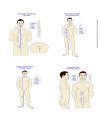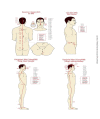Fascial neuromodulation: an emerging concept linking acupuncture, fasciology, osteopathy and neuroscience
- PMID: 31579478
- PMCID: PMC6767840
- DOI: 10.4081/ejtm.2019.8331
Fascial neuromodulation: an emerging concept linking acupuncture, fasciology, osteopathy and neuroscience
Abstract
According to Traditional Chinese Medicine "acupuncture is believed to restore the balance between Yin and Yang" and this can be understood in the Western medicine terminology as a "modulation of the equilibrium between parasympathetic and sympathetic activity". The vast majority of studies concerning the mechanisms of action of acupuncture have been conducted on its influence on pain, and it has been proposed that acupuncture may indirectly relieve chronic pain by its effects on autonomic nervous system function. Several studies have shown that acupuncture recruits brain networks involved in the integration of multiple other brain functions: for example, the limbic-paralimbic-neocortical network, which plays a major role in modulating the affective dimensions of pain processing and the integration of emotional, sensorimotor, autonomic and immunological functions. It has been recently proposed that mechanical signaling through the connective tissue, along with transmission of the matrix deformation through the fascial system network, can explain the therapeutic effect of acupuncture. This model of acupunture, which involves the transduction of mechanical signals through the connective planes and produces a secondary involvement of neurophysiological mechanism, appears to fit very closely to the ancient model. It is also compatible with the proposed neurophysiological explanation. Furthermore, it appears to be fruitful also in manual therapy approaches. Drawing on the basis of the "Fascial network hypothesis of meridians", in which there is an overlap between the channels network described by Traditional Chinese Medicine and the newly-defined fascial system, I propose an intervention through a combination of acupoints that have been selected due to their relationship between "extraordinary acupuncture channels", the myofascial sequences described by Stecco, and the emotional and adaptive function as contemplated by a psychosomatic model used in posturology. This intervention is aimed at treating both stress and postural imbalance.
Keywords: acupuncture; fascial system; neuromodulation; osteopathy; posturology.
Conflict of interest statement
The author confirms that he read the Journal’s position on issues involved in ethical publication and affirms that this report is consistent with those guidelines.
Figures


Similar articles
-
[From meridians and acupoints to self-supervision and control system: a hypothesis of the 10th functional system based on anatomical studies of digitized virtual human].Nan Fang Yi Ke Da Xue Xue Bao. 2007 May;27(5):573-9. Nan Fang Yi Ke Da Xue Xue Bao. 2007. PMID: 17545059 Chinese.
-
Mechanism of acupuncture on neuromodulation in the gut--a review.Neuromodulation. 2011 Jan;14(1):8-12; discussion 12. doi: 10.1111/j.1525-1403.2010.00295.x. Epub 2010 Oct 7. Neuromodulation. 2011. PMID: 21992155 Review.
-
A New Theory on the Evaluation of Traditional Chinese Acupuncture Mechanisms from the Latest Medical Scientific Point of View.Acupunct Electrother Res. 2015;40(3):189-204. doi: 10.3727/036012915x14473562232987. Acupunct Electrother Res. 2015. PMID: 26829844
-
[Study on the meridians and acupoints based on fasciaology: an elicitation of the study on digital human being].Zhongguo Zhen Jiu. 2006 Nov;26(11):785-8. Zhongguo Zhen Jiu. 2006. PMID: 17165500 Chinese.
-
Neurophysiological basis of acupuncture-induced analgesia--an updated review.J Acupunct Meridian Stud. 2012 Dec;5(6):261-70. doi: 10.1016/j.jams.2012.07.017. Epub 2012 Aug 22. J Acupunct Meridian Stud. 2012. PMID: 23265077 Review.
Cited by
-
Efficacy comparison of acupuncture and balanced acupuncture combined with TongduZhengji manipulation in the treatment of acute lumbar sprain.Am J Transl Res. 2022 Jul 15;14(7):4628-4637. eCollection 2022. Am J Transl Res. 2022. PMID: 35958477 Free PMC article.
-
Myofascial points treatment with focused extracorporeal shock wave therapy (f-ESWT) for plantar fasciitis: an open label randomized clinical trial.Eur J Phys Rehabil Med. 2022 Feb;58(1):85-93. doi: 10.23736/S1973-9087.21.06814-3. Epub 2021 Nov 17. Eur J Phys Rehabil Med. 2022. PMID: 34786906 Free PMC article. Clinical Trial.
-
UHPLC-MS/MS analysis of cAMP and cGMP in rat plasma as potential biomarkers of Yin-Yang disharmony in traditional Chinese medicine.J Pharm Anal. 2021 Aug;11(4):458-464. doi: 10.1016/j.jpha.2020.09.001. Epub 2020 Sep 5. J Pharm Anal. 2021. PMID: 34513121 Free PMC article.
-
Objectivization study of acupuncture Deqi and brain modulation mechanisms: a review.Front Neurosci. 2024 May 3;18:1386108. doi: 10.3389/fnins.2024.1386108. eCollection 2024. Front Neurosci. 2024. PMID: 38765671 Free PMC article. Review.
-
Prospective, Single-Center Comparison of Transcranial Direct Current Stimulation Plus Electroacupuncture and Standard Analgesia in Patients After Total Knee Arthroplasty: Effect on Rehabilitation and Functional Recovery.Med Sci Monit. 2021 Jun 9;27:e930363. doi: 10.12659/MSM.930363. Med Sci Monit. 2021. PMID: 34103464 Free PMC article.
References
-
- Takahashi T. Mechanism of acupuncture on neuromodulation in the gut - a review. Neuromodulation 2011;14:8-12. doi:10.1111/j.1525-1403.2010.00295.x - PubMed
-
- Hori E, Takamoto K, Urakawa S, et al. Effects of acupuncture on the brain hemodynamics. Auton Neu-rosci 2010. 28;157(1-2):74-80. doi:10.1016/j.autneu.2010.06.007 - PubMed
-
- Nishijo K, Mori H, Yosikawa K, Yazawa K. Decreased heart rate by acupuncture stimulation in humans via facilita-tion of cardiac vagal activity and suppression of cardiac sympathetic nerve. Neurosci Lett 1997. 23;227:165-8. - PubMed
LinkOut - more resources
Full Text Sources

